Panang Chicken Curry is a peanut-spiked gravy cooked with a homemade spice paste. This full-bodied creamy curry is flavored with Thai basil leaves, lime zest, and coconut palm sugar in a coconut milk base. All components of this dish are in harmony with the nutty flavor of the peanuts, while the warm aroma of spices and herbs makes it a smooth, bold, tangy, sweet, and fragrant curry!
My husband would chuckle when we order the Panang Chicken Curry. He calls it the most memorable misnomer of culinary history that he has come across so far. Let me explain:
- Panang is the Thai phonetic transliteration of the Northern Malaysian state of Penang. Penang was a province of the Sultan of Kedah, who was then a Siamese vassal. Sir Francis Light of the East India Company negotiated the acquisition of the island in return for British military protection.
- Curry is a pervasive expression of a dish composed of a sauce or gravy seasoned with a mixture of ground spices. While Indian in origin and exported globally by the British, this sobriquet has become a veritable catchall for any dish with a sauce composed of ground spices.
Origin:
The aforementioned is my husband’s preferred version of the etymology of the Panang Chicken Curry. However, there is an alternate version that traces the dish back to Central Thailand or even Laos. The earliest written record traces the dish back to the 1890s, and it was called phanaeng which means “cross” that refers to sitting cross-legged on the floor. In this version, the moniker stuck because the cooks would grill the chicken by hanging it upright with its legs crossed and baste it with a spice mix before cooking it in coconut cream. I suppose it’s just as plausible, but it somehow doesn’t have the romance of Penang’s history.
The other thing I wanted to touch on was the color categorization of curries. It is important to understand that curries obtain their natural color based on the nature and proportions of herbs and spices. Yes, you can use coloring to obtain the same effect. I dislike this because the coloring is meaningless if you cannot relish the effect of the spices and herbs. It’s one of my pet peeves when I eat at some restaurants. Sometimes, even though the color of the curry is different, the dish tastes the same. This tells me that the cook or chef is using artifice instead of natural ingredients to create the dish. Don’t get me wrong. I love colorful dishes but not at the cost of losing the natural flavors that create the color.
Summary of Thai color-coded curries:
Green Curry:
When made naturally, the green curry gets its color from the nature of fruit and herbs used to make it. In addition to the combination of green chilis (yes, it is a fruit) used to spice up the dish, it also contains a healthy portion of fresh cilantro, kaffir (or makrut) lime leaves, and green basil. Grind all this greenness up et voilà – you have the green curry. Since it has copious amounts of young, green chilis, it tends to be the spiciest of Thai curries.
Red Curry:
While the red curry is certainly worthy of respect on the Scoville scale, it is less piquant that its green cousin. Like its green cousin, it uses an extensive amount of red chilis. These chilies are crushed with shallots, garlic, lemongrass, and galangal and then cooked down in coconut milk to produce the sauce.
Yellow Curry:
Yellow, gold, or orange, well you get the idea. While there are such things as yellow chilis and orange chilis, the majority of the color for this dish comes from the use of yellow mustard seeds and the spice, turmeric (Curcuma longa). During my visits to Thailand, the yellow curry was the most common type of curry that was made with and without coconut milk.
Massaman Curry:
Common throughout central and southern Thailand, this dish easily has the richest assortment of fruit, herb, and spices of any Thai curry. It contains, chilis, garlic, lemongrass, galangal, shallots, cardamom, nutmeg, cloves, coriander, cumin, and cinnamon, as well as kaffir leaves and coconut milk. It’s further garnished with potatoes and peanuts or even stewed in peanut sauce.
What are the ingredients in the Panang Chicken Curry?
So now we come back to the Panang Chicken Curry. Like the Massaman, its history is also a reflection of trade influences. The dish is made from sundried chilis, coconut cream, lemongrass, kaffir lime leaves, garlic, galangal, shallots, cilantro, and cumin. These ingredients are ground together with peanuts to provide a mellow rounded flavor that allows the tongue to taste the sharpness of the spices and herbs safely. Coconut milk or cream provides a sweeter and thicker base from which to explore the flavors of both the spices and the proteins. You can substitute it, but I assure you that the coconut cream is a better taste enhancer because of the fats.
Homemade curry paste’s distinct ingredients:
- Galangal: If you plan on making this dish, a trip to the Asian grocery stores is a must. Galangal adds a distinct flavor to most Southeast Asian recipes such as Laksa Lemak.
- Lemongrass: Making the spice paste is not hard if you have all the ingredients. Lemongrass is a must-have in this recipe or you could also refer to my homemade red curry paste in Thai Coconut Soup Recipe.
- Dried red chilis: Sundried whole red chilis give the curry its heat and flavor. Deseed them before you soak to make the paste.
- Shallots: These ingredients are very specific to making Thai food. Although onions can be substituted, I always strive to go for the most authentic flavor.
- Whole spices: Whole coriander seeds, cumin seeds, white peppercorns, whole cinnamon and cloves are the other spices that you need to round off the paste. Yes, store-bought paste is an option, but my approach is to make everything from scratch that you will not like want to do takeout again.
For the curry:
- Protein: I have used chicken that I believe complements the curry well. Tofu, shrimp or any other meat and veggies can be also be used in this curry.
- Turmeric: I usually have fresh turmeric at home in my herb box. However, turmeric powder is fine.
- Kaffir lime leaves: This ingredient has been tricky to find here in the San Francisco Bay Area. So my go-to substitute has been lime zest, lemongrass in the spice paste and a dash of tamarind pulp. Sometimes, the frozen aisles have the makrut lime leaves but I like the fresh ones better.
- Thai basil leaves: I grow my own herbs indoors so that I have them year round. You could substitute with any other basil although they vary by flavor.
- Roasted peanuts: Slow roasted and crushed peanuts give the curry a nutty flavor. Peanut butter has never been my option but can be readily used.
- Coconut palm sugar: Dark brown sugar or any sugar can be used if you cannot find coconut palm sugar. Every single ingredient is carefully chosen and put together to make this meal an extraordinary one.
- Tamarind pulp: Tamarind pulp or even a pinch of tamarind is good enough. Since I could not find kaffir leaves, I used tamarind instead to accentuate the flavor.
- Fish sauce: This ingredient, in my opinion, should not be used excessively. Some restaurants use fish sauce liberally that it just overpowers and overshadows all the above delicate and fragrant ingredients.
The best Panang Chicken Curry that I have tasted was in Melbourne, Australia. When I place my order, I usually request that they add less oil to the dish because I do not like greasy food. In this case, the waitress mentioned that the chef does not add any oil to the Panang Chicken Curry but instead uses coconut cream to sauté the garlic with their own spice paste and fresh ingredients.
I was inspired by this unique step. I recreated his dish with my own spice mixtures and proportions. I usually jot down these tips in my notepad for future reference. After decades of making this curry, I know that friends and family have loved it very much which is why I am sharing it on my blog.
Ever since, I have tinkered with my Panang Chicken Curry recipe, and I am now quite content with it. It does not taste like frozen food as there are no additives but only fresh ingredients. The proportion of spices and herbs are balanced in this recipe. I hope that you will also love this dish and add this to your list of favorite recipes. Once you try this dish, you will be hooked too!
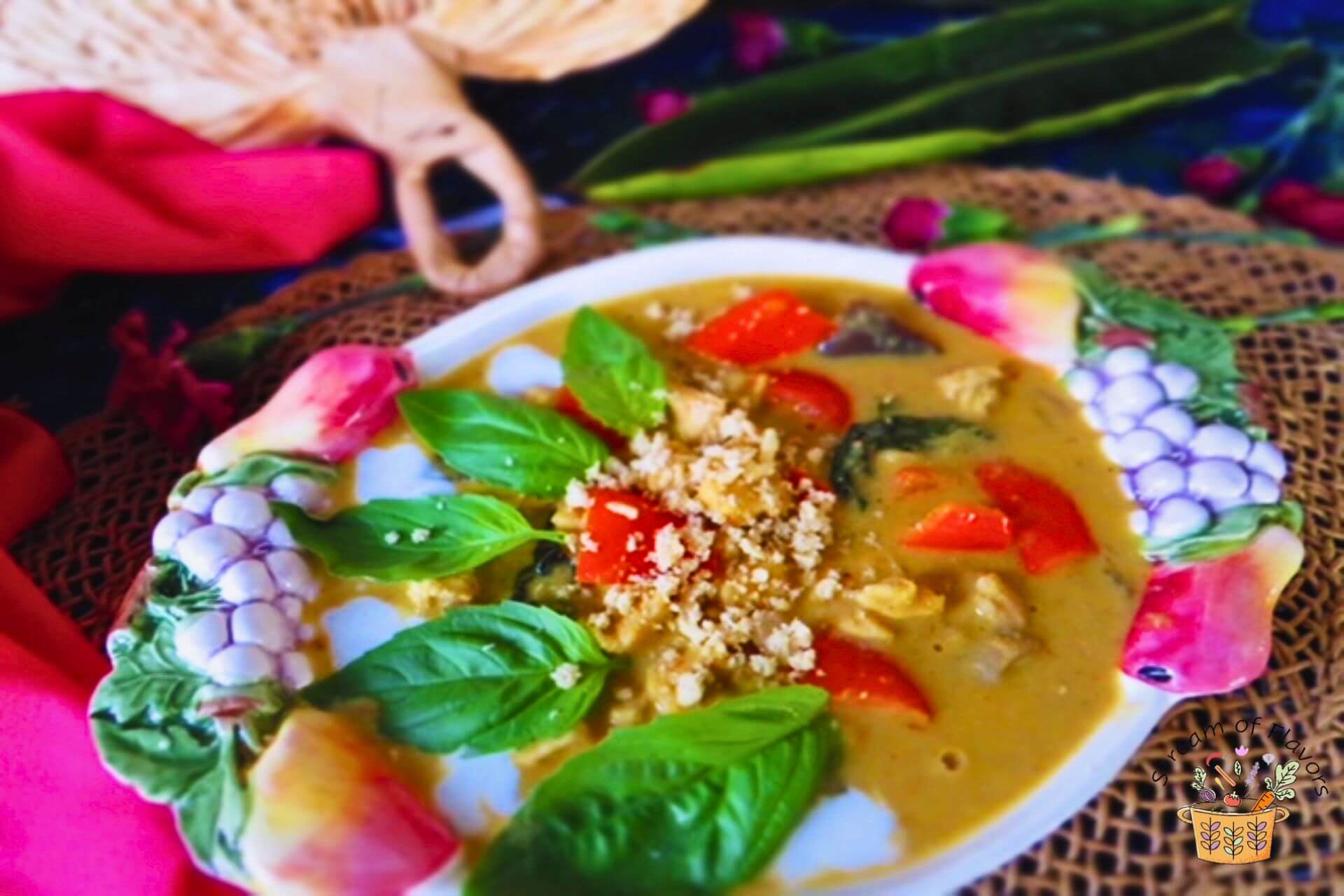
How to make Panang Chicken Curry:
- How to make the spice paste:
- How to make the curry:
- How to make the spice paste:
- Grind the dried spices first using a stone mortar and pestle or a coffee grinder.
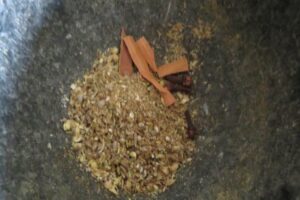
- Add the rest of the ingredients and grind to a paste.
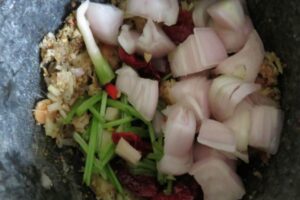
- Add a little water if necessary to make a somewhat smooth paste. Keep aside.
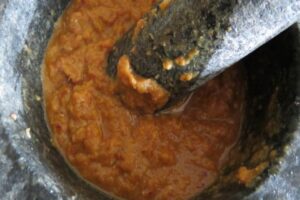
2. How to make the curry:
- Heat a wok with the coconut cream in it.
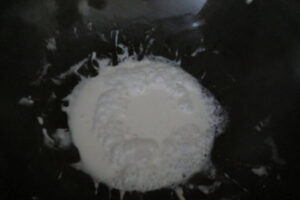
- Add the spice paste and stir until fragrant for a minute or two. Then, add the coconut palm sugar, cut curry leaves, and half of the basil leaves.
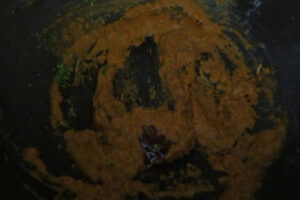
- Add the chicken, turmeric and salt. Cook for 5 minutes, stirring occasionally.
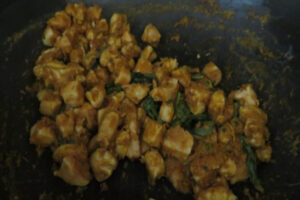
- Pour the coconut milk into the wok. Add the lime zest, tamarind pulp, pepper, and most of the ground peanuts. Simmer for 5 minutes.

- Turn off the heat once the curry has thickened to your desired consistency. Garnish with basil leaves and crushed peanuts.
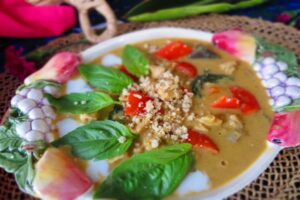
1. The spice paste must be as smoothly ground as possible without chunks. Grinding in a stone mortar and pestle enhances the flavor of the paste and hence the curry. (Store-bought pastes need not be fried in the coconut cream but added directly after addition of the coconut milk).
2. You could grind the ingredients in any grinder but start by pulsing the dry ingredients and then adding the wet ingredients for best results.
3. I make coconut oil by heating the thick homemade coconut milk. You could use coconut oil if you do not have fresh coconut milk. (Alternatively, use the thick top layer of a canned coconut milk for the curry).
4. To thicken the curry, cook for more time and the gravy will thicken by evaporation or add more water or coconut milk to dilute it.
5. Kaffir or makrut leaves have a very distinct flavor but since I did not have them, I used some tamarind pulp and lime zest. You could instead use a big pinch of some tamarind in the gravy.
Storage and serving suggestions:
Panang Chicken Curry can be frozen for three months or refrigerated for 2 days since curry made with fresh coconut milk has a shorter shelf life. Serve this dish on a bed of steamed jasmine rice or any rice of your choosing.
Panang Chicken Curry
Equipment
- Wok
Ingredients
For the spice paste:
- 4 dried red chili
- 2 clove garlic
- 2 shallot
- 1 tablespoon galangal peeled, minced
- 1 cilantro root
- 1½ teaspoon coriander seeds
- 1 teaspoon cumin seeds
- 1 teaspoon white peppercorn
- 1 cinnamon stick small
- 3 clove
For the curry:
- 1 lb chicken breast cubed
- 1½ tablespoon coconut cream
- ¼ teaspoon ground turmeric
- 4 curry leaves
- 1 pepper chopped
- 1 lime zest
- 1 teaspoon tamarind pulp
- 10 Thai basil leaves
- 1 teaspoon coconut palm sugar
- 1¼ teaspoon salt
- 3 cup coconut milk fresh
- 1½ teaspoon fish sauce
- 2 tablespoon roasted peanut crushed
Instructions
How to make the spice paste:
- Grind the dried spices first using a stone mortar and pestle or a coffee grinder.
- Add the rest of the ingredients and grind to a paste.
- Add a little water if necessary to make a somewhat smooth paste. Keep aside.
How to make the curry:
- Heat a wok with the coconut cream in it.
- Add the spice paste and stir until fragrant for a minute or two. Then, add the coconut palm sugar, curry leaves and half of the basil leaves.
- Add the chicken, turmeric and salt. Cook for 5 minutes, stirring occasionally.
- Pour the coconut milk into the wok. Add the lime zest, tamarind pulp, pepper, and most of the ground peanuts. Simmer for 5 minutes.
- Turn off the heat once the curry has thickened to your desired consistency. Garnish with basil leaves and crushed peanuts.
Notes
- Chicken can be substituted with tofu or any meat.
- This recipe can be substituted using canned coconut milk, panang curry paste, frozen kaffir leaves, dried ginger, and peanut butter if you are cannot find the unique ingredients.
Nutrition


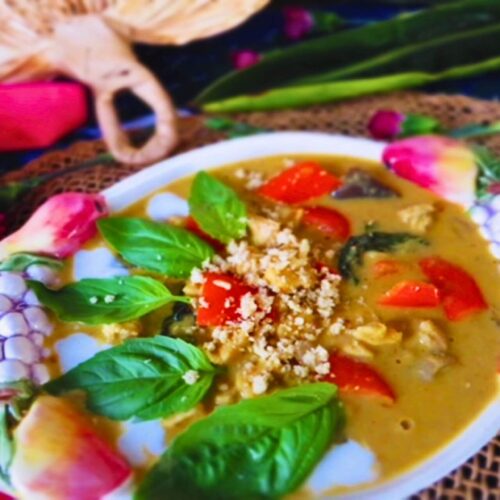
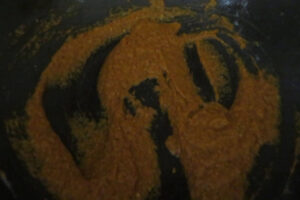




















0 Comments